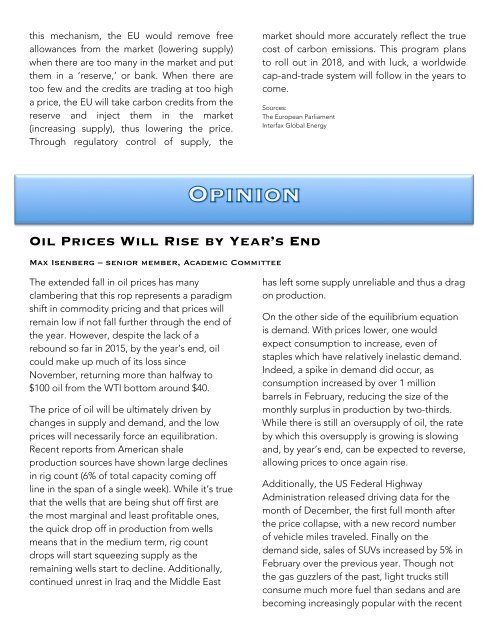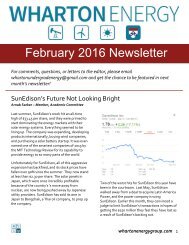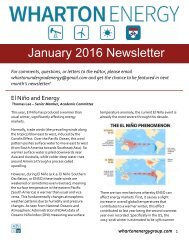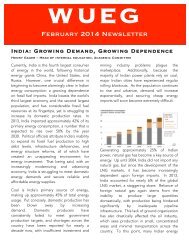You also want an ePaper? Increase the reach of your titles
YUMPU automatically turns print PDFs into web optimized ePapers that Google loves.
this mechanism, the EU would remove free<br />
allowances from the market (lowering supply)<br />
when there are too many in the market and put<br />
them in a ‘reserve,’ or bank. When there are<br />
too few and the credits are trading at too high<br />
a price, the EU will take carbon credits from the<br />
reserve and inject them in the market<br />
(increasing supply), thus lowering the price.<br />
Through regulatory control of supply, the<br />
market should more accurately reflect the true<br />
cost of carbon emissions. This program plans<br />
to roll out in 2018, and with luck, a worldwide<br />
cap-and-trade system will follow in the years to<br />
come.<br />
Sources:<br />
The European Parliament<br />
Interfax Global Energy<br />
Oil Prices Will Rise by Year’s End<br />
Max Isenberg – senior member, Academic Committee<br />
The extended fall in oil prices has many<br />
clambering that this rop represents a paradigm<br />
shift in commodity pricing and that prices will<br />
remain low if not fall further through the end of<br />
the year. However, despite the lack of a<br />
rebound so far in <strong>2015</strong>, by the year’s end, oil<br />
could make up much of its loss since<br />
November, returning more than halfway to<br />
$100 oil from the WTI bottom around $40.<br />
The price of oil will be ultimately driven by<br />
changes in supply and demand, and the low<br />
prices will necessarily force an equilibration.<br />
Recent reports from American shale<br />
production sources have shown large declines<br />
in rig count (6% of total capacity coming off<br />
line in the span of a single week). While it’s true<br />
that the wells that are being shut off first are<br />
the most marginal and least profitable ones,<br />
the quick drop off in production from wells<br />
means that in the medium term, rig count<br />
drops will start squeezing supply as the<br />
remaining wells start to decline. Additionally,<br />
continued unrest in Iraq and the Middle East<br />
has left some supply unreliable and thus a drag<br />
on production.<br />
On the other side of the equilibrium equation<br />
is demand. With prices lower, one would<br />
expect consumption to increase, even of<br />
staples which have relatively inelastic demand.<br />
Indeed, a spike in demand did occur, as<br />
consumption increased by over 1 million<br />
barrels in February, reducing the size of the<br />
monthly surplus in production by two-thirds.<br />
While there is still an oversupply of oil, the rate<br />
by which this oversupply is growing is slowing<br />
and, by year’s end, can be expected to reverse,<br />
allowing prices to once again rise.<br />
Additionally, the US Federal Highway<br />
Administration released driving data for the<br />
month of December, the first full month after<br />
the price collapse, with a new record number<br />
of vehicle miles traveled. Finally on the<br />
demand side, sales of SUVs increased by 5% in<br />
February over the previous year. Though not<br />
the gas guzzlers of the past, light trucks still<br />
consume much more fuel than sedans and are<br />
becoming increasingly popular with the recent









